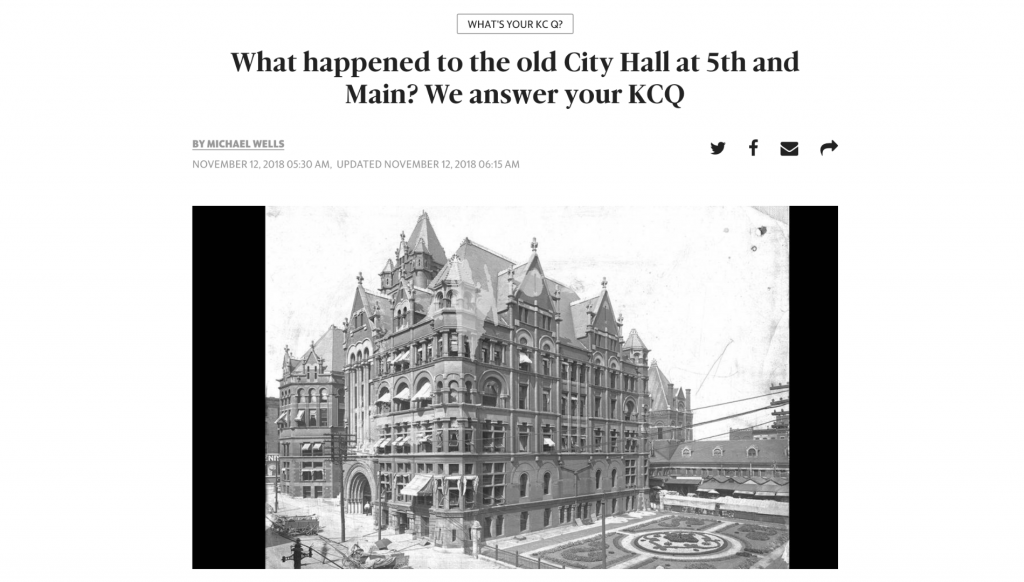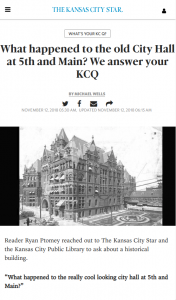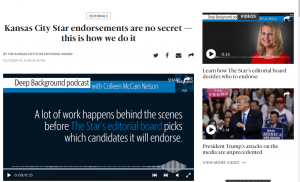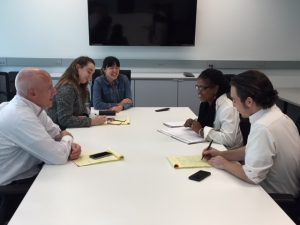KCQ, explainers and more: Kansas City Star goes deeper into transparency and engagement

In mid-November, The Kansas City Star ran a story in the genre we might call an “explainer” — explaining what had become of the the Missouri city’s old city hall, a striking structure from the late 1800s. But this piece had elements that also made the journalism striking: It was part of a pathbreaking collaboration between The Star and the Kansas City Public Library. The Star and library have been asking members of the community what they want to know. And in his response to this particular question, library researcher Michael Wells didn’t just provide the answer; he showed how he’d done his research to find the answer.
 The story — “What happened to the old City Hall at 5th and Main? We answer your KCQ” — was an example of something we at the News Co/Lab are encouraging news organizations to do in an age when journalism has fallen not just on hard economic times but is also losing some of the trust it once enjoyed. We believe, and we are acting on this belief, that journalistic engagement — which we define as deep conversation and collaboration with the communities journalists serve — and transparency are essential parts of improving local news ecosystems, to help communities better understand journalism (and its value) and to help journalists better understand their communities.
The story — “What happened to the old City Hall at 5th and Main? We answer your KCQ” — was an example of something we at the News Co/Lab are encouraging news organizations to do in an age when journalism has fallen not just on hard economic times but is also losing some of the trust it once enjoyed. We believe, and we are acting on this belief, that journalistic engagement — which we define as deep conversation and collaboration with the communities journalists serve — and transparency are essential parts of improving local news ecosystems, to help communities better understand journalism (and its value) and to help journalists better understand their communities.
The “What’s Your KCQ” project is all about engagement, with an added transparency component. It’s one of the experiments we’ve undertaken with The Star in the past year, part of our work with three McClatchy newsrooms (the others are in Fresno, California, and Macon, Georgia) to help journalists become leaders in bringing news fluency (also known as news literacy) to their audiences.
Engagement and transparency range widely in the real world, as we’ve learned in collecting our “Best Practices,” which have been the foundation of the newsroom projects. I’ve spent time with The Star’s newsroom working group, headed by Eric Nelson, regional growth editor for McClatchy’s midwest region, and top editors. From my perspective they’ve put together some fine examples of how a traditional news organization can embed these practices into the journalism. Some highlights:
On the transparency front, The Star is moving ahead quickly. One key example is adding “How we did the journalism” explainers to major stories including investigative projects. In one recent example — “How The Star exposed a serial killer who got away with murder for decades” readers get a deep dive into the journalism required to nail down this astonishing story. (You should read the series, which starts here, to see what fine work The Star did.)
 The transparency has extended to the organization’s commentary pages, where Colleen Nelson, the editorial page editor, wrote about how, and why, The Star does political endorsements and posted a podcast with the article.
The transparency has extended to the organization’s commentary pages, where Colleen Nelson, the editorial page editor, wrote about how, and why, The Star does political endorsements and posted a podcast with the article.
The Star’s editor, Mike Fannin, has been an active supporter of these and other efforts, as he wrote in a letter to readers entitled, “Kansas City, we need each other. So let’s keep the conversation going.” He’s been responding to readers on social media, and told me last week he’s eager to push the process forward.
One of his key goals is to bring the corrections process — still a distinctly 20th century affair at almost all news organizations — into the 21st century. Technology, and an abiding belief that corrections are embedded in genuine transparency, give us ways to make people better aware of mistakes they may have seen. We have some super-interesting work going on in this arena; stay tuned.
Our work with newsrooms, including Kansas City, has been about collaboration in every respect. At The Star, for example, the collaboration with the public library has been astoundingly productive. The organizations teamed up on “Java with Journalists” meetings at branch libraries — a project soon to be expanded to other public library systems in the Kansas City metro area — and, of course, the “What’s Your KCQ” project. The latter has another partner: Hearken, a Chicago-based specialist in what it calls “public powered journalism” in which the public is integral to the reporting. The Star is using Hearken’s online tools to help make this work.

Eric Nelson
Embedding transparency and engagement into a newsroom, with the goal of raising the community’s news fluency, has been a learning process for everyone involved, not just in Kansas City but also in Fresno (California) and Macon (Georgia), where the News Co/Lab has also been working with newsrooms.
Speaking personally, some lessons are already clear. Among them: Each newsroom and community is different, so the engagement/transparency projects need to be tailored to fit the people and place; the principles don’t change but the specific tactics may. The newsroom needs internal champions for the process at all levels of the organization chart. Communication and planning are essential; my regular phone calls with Eric Nelson, who’s led the newsroom side of this effort, have helped keep us focused on what’s needed and when.
It’s been great to renew my acquaintance with The Kansas City Star and the city over the past year. I worked there in the late 1980s and remember the newsroom and the city fondly. Returning on a regular basis has been a joy — and I’m learning a lot. We have more to do, and we could not have better partners.
(Thanks as always to our funders including the Democracy Fund, Facebook Journalism Project, News Integrity Initative, and Rita Allen Foundation.)
Dan Gillmor is a longtime participant in new media and digital media literacy. He’s author of the 2009 book, Mediactive, discussing media literacy in the digital age from a journalist’s perspective.

